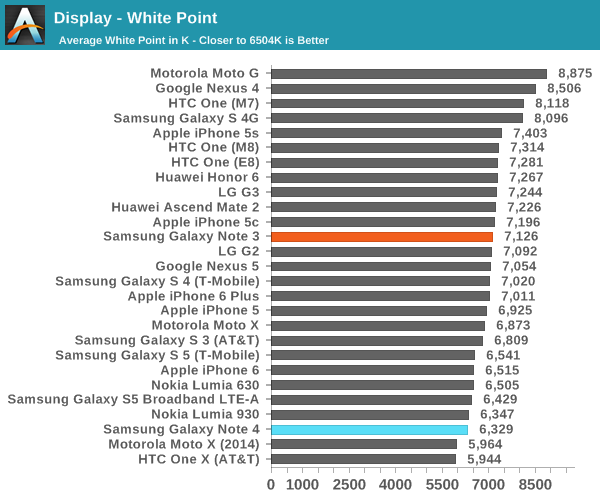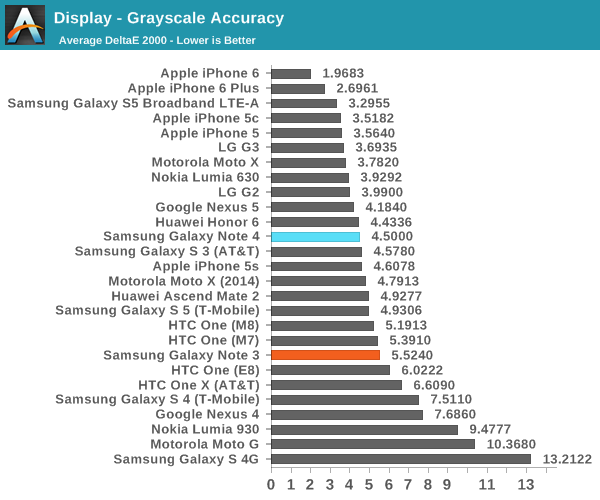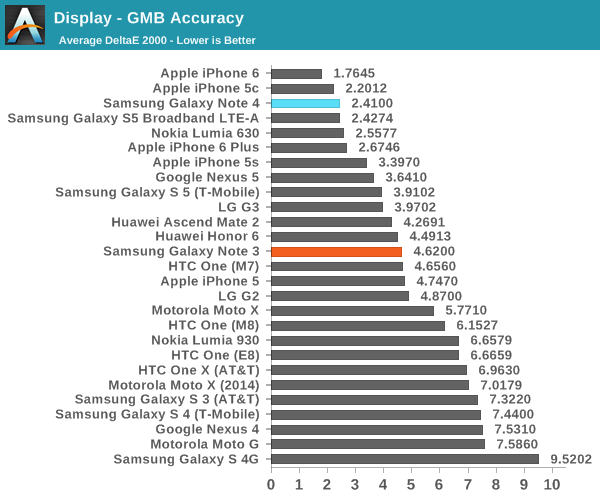The Samsung Galaxy Note 4 Review
by Joshua Ho on October 15, 2014 9:00 AM EST- Posted in
- Smartphones
- Samsung
- Android
- Mobile
- Galaxy Note 4
Display
With the advent of the modern smartphone, the display became one of the most important aspects of the entire experience as it was the only method of interacting with the device. To this end, Samsung has equipped the Galaxy Note 4 with their latest generation AMOLED panel, which has a higher resolution 1440p display, although this is achieved with a PenTile subpixel layout that makes total subpixel density lower than a conventional RGB stripe, so true subpixel density increases around 20% when compared to an RGB stripe 1080p panel. For reference, going from an RGB stripe 1080p panel to a 1440p panel of the same subpixel stripe would have a density increase closer to 80%.
In practice, the visible resolution varies somewhere between the “worst case” where the eye can see the true subpixel density and the best case where the display appears to be an RGB stripe 1440p display. If I look closely it’s still possible to see a fringing patterns in certain cases. Other than these minor cases, the Galaxy Note 4’s display has more than enough resolution for a smartphone use case. This is noticeably better than what I see with the iPhone 6 Plus, although in casual use it’s unlikely that these resolution differences will actually matter in most cases. I definitely think that there will be a visible difference for VR, although even the Galaxy Note 4’s display lacks sufficient resolution to have a “perfect” display in that scenario.
However, resolution is a relatively simple metric to look at. In order to better test the display we must look at other key metrics. In order to do this, we turn to SpectraCal’s CalMAN 5, along with a spectrophotometer for accurate color measurements.

While relatively simple, brightness and contrast are quite important as a display that’s dim or low in contrast will appear to be quite poor. In terms of brightness, we see that Samsung continues to maintain relatively high peak luminance, and a massive improvement when compared to previous generation AMOLED displays. While the normal peak brightness is a bit on the low side, as long as one uses auto-brightness the display’s “boost mode” will be able to activate and reach around 450 nits so in practice sunlight visibility should be more than acceptable. Contrast remains as incredible as it always is with AMOLED displays of this generation, although there still seems to be visible RC delay of some sort as there can be a purple trail effect when pixels transition from an unlit to lit state. I suspect this is mostly unavoidable, and is generally only visible at low brightness.


The next test we’ll look at is grayscale, which can suggest issues with overall tints in the display and issues with gamma. In this area, we see that the display is definitely quite good in overall gamma but unfortunately there’s a bit of a green tint here which causes a regression when compared to the Galaxy S5 LTE-A Broadband. This is really only visible on some certain percentages of gray but it would be an area where some improvement is needed.

While grayscale is one aspect of the display, it’s also important to look at color overall. One of the first tests for color is the saturation sweep, where the Note 4’s display performs admirably. At this point, there’s really not much to point out for improvement as the dE2000 average is low enough that one won’t notice any issues with color accuracy in Basic mode.

Similarly, the display does a fantastic job in the Gretag Macbeth ColorChecker. It should be possible to get a good idea of what a photo will look like on other displays and other similarly color-sensitive work on the Note 4. Samsung has also included other modes for those that want more vivid or otherwise more saturated color, which is of great benefit for those interested in such a color profile. The one potential issue here is that there is color shifting when altering viewing angles. In comparison to the Note 3, the Note 4 has a far better display. As-is, the state of AMOLED seems to be in a dead heat with LCD now as both seem to have their own trade-offs. However, we may soon see a shift as Samsung’s AMOLED becomes indisputably better than even the best LCDs.













195 Comments
View All Comments
akdj - Thursday, October 30, 2014 - link
Sorry. Something was lost in translation there;)I'm not going to go tbrough the dozen+ grammatical and punctuation errors, but my point was to compare iOS to Android with their siblings ...the Chromebook and OS X. Windows has the same if they're able to finally figure phones out! The SPIII is a HELLUVA design and enough difference between itself and the iPad (including the price, you're looking more like comparing a nice 13" rMBP w/Haswell ans Iris Pro graphics;))
Vertical and horizontal support. iOS and OS X with continuity and handoff being another extension of Airdrop is absolutely incredible!
The new near 15million pixel 5K iMac is a Grand Slam
iPad Air 2, it's A8X, a 2 and a ½ gen old 64 bit design---2GB of RAM, & a buck 28 built in with a half million 'optomized' tablet apps for everything from photo and video manipulation with Adobe, MS, & OS X integrated and aggregated alls to music creation, mixing and mastering ...magazines that are mind blowing, killer browser choices and unbelievably powerful video editing suites, drawing and sketching programs...old 'Chilton' fix 'em up guides or ForeFlight to file your F/P n tell ya how much gas you should pump in, while it considers diversions and real time weather and traffic. TCAS ans ADSB ...Jep charts, plates and updates in 'now' time, THAT'S a 'Tool!'
Farting around with ROMS is like rewiring your microwave. Why? It's to cook, melt, boil, or pop your F'ung popcorn!
tipoo - Wednesday, October 15, 2014 - link
Indeed. I'm excited for Nvidias Denver CPU cores, finally someone else going with two big cores rather than four small.mpokwsths - Wednesday, October 15, 2014 - link
Something is not right here..."Around 450 nits" with auto brightness on???
Displaymate strongly disagrees with Anandtech. They measured "478 - 750 cd/m2" with auto brightness (1 nit = 1 cd/m2)
http://www.displaymate.com/Galaxy_Note4_ShootOut_1...
melgross - Wednesday, October 15, 2014 - link
There is variability in production. The differences you are seeing are well within that variability.mpokwsths - Wednesday, October 15, 2014 - link
Don't be ridiculous, please...Displaymate: "When Automatic Brightness is turned On, the Galaxy Note 4 reaches an impressive 750 cd/m2 in High Ambient Light, where high Brightness is really needed – it is the brightest mobile display that we have ever tested"
It is an out-of-space claim that there can be a variability in production of a 70% level...
tralalalalalala40 - Saturday, October 18, 2014 - link
hopefully the display doesn't keep that brightness very long. those pentile pixels will burn out. you'll have to use a screen saver.theduckofdeath - Thursday, October 16, 2014 - link
Sounds like a poor excuse for inaccurate testing to me. If the error margin was that huge, the display would be horrible to look at.JoshHo - Wednesday, October 15, 2014 - link
In practice I find that the 100% APL value is more representative of the perceived brightness, this is due to a difference in testing methodology.Pissedoffyouth - Wednesday, October 15, 2014 - link
I just bought a note 3, and I'm more than happy with it with a zerolemon 10000mah battery. This doesn't really offer much more really, more of an slight upgrade.I'd be interested to see why they didn't up the battery a little more considering they made the chassis bigger...
darkich - Wednesday, October 15, 2014 - link
I find it impossible not to notice the Apple reality distortion effect in this article.But nice try hiding it, AT.
I'll just state a fact proven by pretty much every other review - battery endurance on this device is clearly better than that on the iPhone 6+.